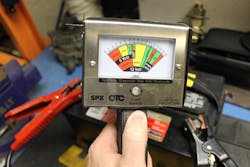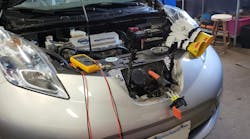Alternators serve two distinct purposes on any vehicle, the first is to provide power to meet all of the electrical needs while the engine is running (electrical system, lights, interior accessories, etc). The second is to charge the battery, so it will have enough power to prime the fuel pump, crank the engine and start the vehicle.
There are many things that go wrong with the electrical systems on a vehicle, and typically it will boil down to something other than a major component. Corrosion, grounding issues and open circuits are the three main culprits when you are trying to find a problem. So, rather than “throwing parts at it”, first you will need to try and pinpoint what is actually wrong.
Q: The customer complains that the car won't start in the morning without a jump, and the battery/charging light stays on while driving. Doesn't that mean the alternator is having a problem?
A: Not necessarily. There are a few things right off the bat that you need to check before replacing parts, because many times this can be something as simple as a loose or corroded battery connection.
Pop the hood and look at the battery terminals/connections. Grab the positive connection and wiggle it…. if no movement, repeat with the negative side. If either can move at all, either tighten them to prevent movement or replace the connectors to ensure a tight fit.
If you see any corrosion, you need to remove the terminals, clean the corrosion off of the battery posts and the terminals, then reinstall. You can use battery terminal cleaner such as CRC Battery Cleaner, or you can use plain Coca-Cola to completely eat away the corrosion and douse with water prior to using a wire battery terminal brush to clean everything up.
You should check the battery to ensure that it is in good condition and holding a charge correctly. If batteries are deeply discharged, overcharged, damaged or simply old, they can and will fail. The first step you should do is use a multimeter such as the Milwaukee 221620 Digital Multimeter, and verify the voltage level as being between 12.4V and 12.6V . If the voltage is below 12.4V , you will need to charge the battery first and repeat the test.
Assuming that the voltage is now reading between 12.4V and 12.6V, you should now complete a “load test.” This is done very easily and quickly by using a battery load tester such as the OTC 3181 Load Tester . You hook the positive cable first and then the negative, then press the rocker switch on for 10-15 seconds. The load tester will heat up coils inside (creating a load) and you can watch the dial to see if it stays in the “good," "weak" or "replace” range. The problem that many people have when testing a battery is the fact that they are testing it with no load applied and it will read the correct voltage, and that will hide the fact of “bad cells” inside. By placing a load on the battery, you are mimicking the power draw needed by the starter to turn the engine over.


